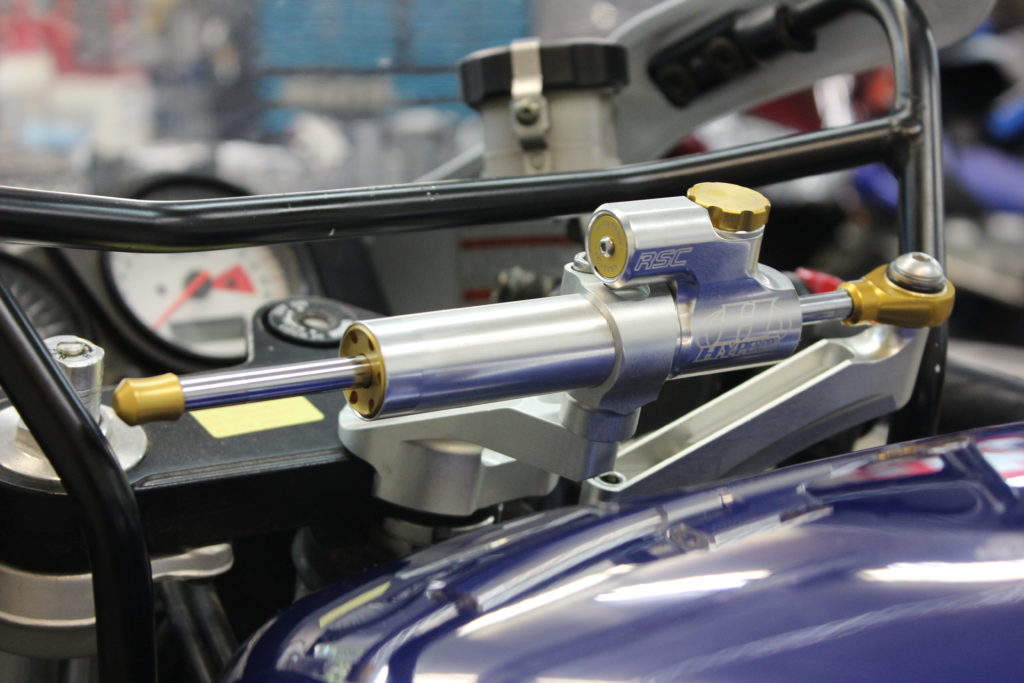Diesels and Turning

I had a question posed a couple weeks ago by a close friend asking why we don’t see Diesel powered motorcycles? The idea is not new, as I have seen a few diesel powered project bikes in the past, but the idea never really caught on. Let’s look at some of the possible reasons why:
I saw a bumper sticker the other day that read “Real trucks don’t have spark plugs”. This is, of course, pointing out the fact that diesel engines don’t trigger combustion in the cylinder head with spark plugs. Diesels instead just use stratospherically high compression ratios, in the neighbourhood of 18 or 20:1, safely double that of a conventional gasoline powered engine, to trigger combustion. Diesels do have glow plugs for cold start up, but those plugs don’t spark, they heat up the cylinder head to aid in the combustion of the diesel fuel when all the parts are cold and perhaps the engine is turning over slower due to the frosty oil in the pan. The result of very high compression ratios, even in a gasoline engine to a lesser extent, is big torque. Simple math tells us that torque goes up when compression ratios climb, but the fly in the ointment of a very high torque engine, is a lower safe operating rpm. However, since torque is climbing rapidly with higher compression, you don’t really need high rpm to get the work done as long as a suitable transmission will match engine rpm to required road speed.
So, due to the demands of their double than normal compression ratios, diesel engines are HEAVY! Cylinders are heavy, the heads are heavy and thick and the cylinder studs and bolts are all super large to handle the combustion loads. Due to the torque produced, the crank shafts are heavy and the engine cases are stronger to contain it all. An engine of enormous mass is acceptable when hidden in a truck, but less appealing when balanced between your legs in a bike, strike one.
Again, diesel engines produce enormous torque at very low rpm, usually offering peak torque in the 1500- 2200 rpm range, which is idle for most motorcycles! Diesel engines as such don’t rev very high, usually peaking at about 4-5,000 rpm and they also emit a low frequency rattle, that no sport bike aficionado finds very appealing, strikes two and three. If the transmission and final drive gearing was selected to suit this torque peak, it would work fine, but the bike would be very low on the fun scale for sure. Having looked at this reality, we can see that the diesel engine is best suited for pulling heavy loads, vs high rpm excitement.
At the pump, diesel fuel foams very easy and can be time consuming to dispense. This reality, combined with the size of the tanks on commercial trucks has evolved the diesel pump’s discharge nozzle into having a very large diameter for quick easy fills for those big trucks. The size and shape of a motorcycle fuel tank would be a nightmare at the pumps with even the most careful riders overflowing stinky diesel fuel all over their pretty bikes. Strike four.
Looking outside the box a bit at the benefits of a diesel, we come to the conclusion that they are best suited to accelerating a heavy load up to a moderate speed. Since bikes weigh next to nothing compared to a truck or even a car, the benefit of the high torque is lost. Bikes can already achieve excellent fuel economy due to their light weight without the need for super high torque. So, I think at this point in time, the extra emission controls required to clean up a diesel engine would definitely offset any perceived benefit in dropping a smaller, lower compression ratio diesel engine into a motorcycle.
The next question we had come across our desks was from a rider trying to understand the phenomena of counter-steering a motorcycle. He swears it is a myth, citing examples of positive steering the right way around obstacles in his driveway. Well, lets just say you are both right.
At very low speeds riding a motorcycle or bicycle is all about vertical balance. A successful rider will move weight left or right using the shoulders, hands and feet to keep a motorcycle upright. Once forward motion is above a walking pace, the rider will also turn the handlebars back and forth, which pulls the bike left or right under the rider and aids in staying upright. Once this harmony is operational and the bike is somewhat stable a right turn is indeed accomplished by turning the bars to the right. At VERY slow speeds, the bike and rider can stay balanced somewhat upright, as the motorcycle turns to the right. If a tighter turning radius is desired, the bike can be leaned over to get the bike onto the side of the tire which will tighten up the radius trying to be achieved. However, at slow speeds leaned over the bike will begin to fall over and the rider has to correct by either putting the inside foot down and pivoting around it, or, he or she must open the throttle rather forcefully to induce acceleration. This accelerating force can be modulated with some practice to balance the inward fall, and if successful, the rider can carefully and expertly shoot out of the tight corner and accelerate away. This cornering style is much more common with off road bikes than street bikes.
Once the motorcycle and rider is above a jogging pace, different forces start to come into play that change things. We have all heard of the experiment to demonstrate gyroscopic force, where an individual holds a bicycle wheel by the axle and pivots it around very easily. Then they had a friend spin the wheel as fast as they could and they then try and repeat the motions. The spinning wheel is far harder to move about it’s axle as the gyroscopic force of the spin gives it incredible stability. Well, a motorcycle in motion has typically 3 heavy spinning gyros all turning in the same direction to induce significant stability. The first two are obviously the two spinning rims, tires and brake rotor assemblies, while the third is the less obvious crankshaft. The crankshaft adds to the gyroscopic stability if the bike has an engine with a crank placed longitudinally across the frame like all current inline 4s, inline 3 cylinders, most twins and almost all singles, and, if the crankshaft is indeed turning in the same direction as the wheels. The BMW Boxer engine is a notable exception with the crankshaft situated front to back and the cylinders orientated left and right. Anyway, when 3 gyros combine forces, the bike can become very hard to turn at elevated speeds. Once the bike is being governed by these gyroscopic laws, counter-steering is required to turn the motorcycle. To over simplify counter-steering, a push forward on the right bar will begin moving the front of the bike to the left. With the front wheel quickly heading left, the bike basically falls over onto its right side. The bike will now turn right on a radius that is balanced by the centripetal forces acting outwards to push the bike upright, yet held online by a steady light force outward on the inside handlebar. The amount of trail engineered into the fork offset will affect the required force on the handlebar.
